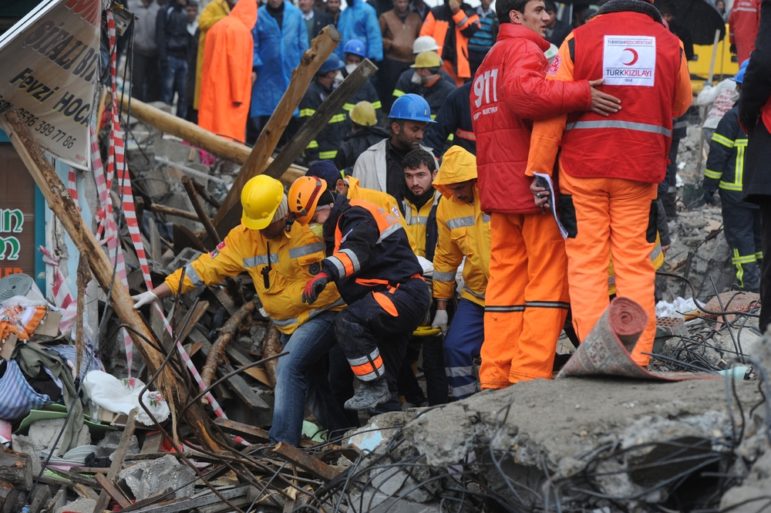10 Investigative Questions to Ask after a Natural Disaster


Investigative reporters should look into what political decisions and policies helped worsen natural disasters, like the recent earthquakes in Turkey. Image: Shutterstock
The disastrous February 6 earthquake in Turkey and Syria has reminded the world’s journalists that, increasingly, “natural disasters” are not entirely natural — and are often made far worse by human missteps, neglect, or corruption.
For instance, while dozens of building contractors linked to collapsed buildings have been arrested in Turkey, many of those structures were never strengthened due to reckless amnesty laws pushed through by politicians and other officials who have not been held accountable.
As of mid-February, at least 40,000 people had died — a toll made much worse by this enabled neglect, according to experts.
Given the impact of climate change, corruption, and the erosion of democratic institutions in the past decade, it is more important than ever that watchdog reporters actively investigate the aftermath of floods, earthquakes, tsunamis, volcanic eruptions, and typhoons, and hold key players to account — whether remotely or in the field.
The founder of the Nepal Investigative Multimedia Journalism Network, journalist Rajneesh Bhandari, covered the aftermath of the 2015 Nepal earthquake for The New York Times, National Geographic, and other outlets. That event killed about 9,000 people.
“I was at a traffic police station using their internet to send my first story out,” he recalls of a video piece he did for The Times.
Bhandari says disaster investigations feature many of the classic watchdog methods, such as databases and remote sensing tools, social media search, and following the money — especially, he says, in the reconstruction phase, where the potential for corruption is high. However, he notes that these stories require extra effort by investigative journalists: to report from the field (or partner with a collaborator on site); to show empathy for survivors and grieving families; and to continue asking new and creative questions in the weeks and months after the event.
A good starting point for watchdog reporters is to eliminate the idea that damage from a natural disaster like the earthquakes in Turkey is simply because of “acts of nature.” Think of it, instead, as a mix of hazardous events and human actions. And then start following the forensic trails: the money, the people, the unforeseen needs, the accountable officials. Your investigation may well be the first to point out what really happened, and potentially save lives in the future.
With that in mind, here are 10 questions for investigative editors and reporters to ask — of their sources, and of themselves.
1. Where did the relief money go — and where are the choke points that stop the flow? Disasters trigger the release of millions of dollars in aid, reconstruction grants, and relief resources. In addition to cases of corruption, journalists have often revealed alarming distribution mistakes and systemic delivery failures that divert or stall that money. The Centre for Investigative Journalism, Nepal, produced an outstanding watchdog story on choke-points in reconstruction funding, following Nepal’s devastating earthquake in 2015, which showed that only 3% of the money had helped displaced survivors after 21 months. Key money-trail questions to ask: “Who are the key figures in the distribution chain — and who has oversight?,” “Have emergency provisions or food been stolen or diverted to black market economies?,” and “How were private service providers chosen, and did they deliver on those contracts?”
2. Was the disaster made worse by human actions — before and after the event? This single question can trigger numerous investigative angles — from quick stories on planning failures and communication foul-ups to the longer-term effects of climate change. With few exceptions, natural disasters are generally foreseeable and can be mitigated with planning, resource allocation, and — in cases like hurricane storm surges, volcanic eruptions, and tsunamis — even timely public warnings. And damage and loss of life can be limited by effective and coordinated government mobilization, as was seen in the successful response to the 7.1 magnitude Canterbury earthquake in New Zealand in 2010 — which killed only one person.
3. Could the disaster have caused leaks or toxic contamination from nearby sites? The Fukushima nuclear disaster — and the technical and communication errors involved — following the 2011 tsunami in Japan is the best-known example. But earthquakes, floods, and tsunamis can trigger ripple effects like contamination from damaged oil refineries, military bases, and chemical plants, which are often not revealed without journalistic digging.
4. Was the death toll exacerbated by corruption or cronyism? According to one study in the journal Nature, 83% of all deaths from collapsed buildings due to earthquakes in recent decades occurred in countries characterized by systemic corruption. The authors noted that poor construction practices are “largely to blame for turning moderate earthquakes into major disasters.” In other cases, irresponsible leaders have installed incompetent cronies in critical emergency response posts, while corruption and the illicit diversion of relief funds have led to further loss of life, as allegedly occurred after Pakistan’s massive floods in 2022.
5. What does the data say about problems at emergency management agencies, or in disparities in disaster assistance? In 2021, Washington Post data journalist Andrew Ba Tran dug deeply into government databases to show that the rate of assistance approvals from the US Federal Emergency Management Agency (FEMA) plunged from 63% in 2010 to just 13% in 2021. The team also compared assistance data with race categories in census data to show that assistance had been systematically denied to Black disaster survivors in America’s “Deep South.”
6. How can we report on apparent looting and lawlessness among survivors in an ethical way? Not precisely an investigative angle, but worth noting nonetheless: Be careful about stereotypes and bias. As researcher Nadia Dawisha found in an analysis of news coverage of the 2005 Hurricane Katrina disaster in the US, Black survivors were often described in terms of lawlessness, while white survivors were portrayed as seeking help. She pointed out how one African-American person seen carrying food from a store was described as a “looter,” while a white person doing the same was “finding food.” Experts stress that journalists should take care to avoid stereotypes, and to report on looting-type incidents in the context of the conditions facing each affected community.
7. What can we learn from the new emergency response players? As Josephine Schmidt, executive editor of The New Humanitarian, told GIJN, disaster response – and the “$30 billion humanitarian aid industry” — are no longer the exclusive business of governments, the United Nations, and “big aid.” They now include private individuals, online communities, and even volunteer firefighters who travel to disasters at their own expense. These players can provide important and credible independent facts, valuable access, and even act as whistleblowers.
8. What public health threats could be triggered by the initial disaster? New conditions created by disasters — especially contaminated drinking water and sanitation failures — have often created new waves of deaths from disease after natural disasters. In addition, disruptions to critical everyday health services — from tuberculosis tablets to prenatal care and ventilators — need to be closely examined.
9. Who is exploiting the disaster? Past disasters have seen an alarming variety of opportunists emerge — from ideological disinformers to corrupt officials and scammers posing as victims to hijack donations online. Weeks after the Haiti earthquake in 2010, an off-duty official at Port-au-Prince’s damaged international airport attempted to extort this reporter and a private pilot in exchange for our right to leave, causing the pilot to have to taxi the plane away from a violent gang summoned by that official.
10. What are we missing here? From the lack of skilled artisans needed for reconstruction projects to poor communities dumped in the path of likely calamities, the issues that follow disasters are so numerous they require regular editorial brainstorming. Let us know if you have ideas to add, and we’ll integrate them into a larger disaster investigations guide we’re working on.
Additional Resources
Resources for Finding and Using Satellite Images
Climate Crisis: Ideas for Investigative Journalists

Rowan Philp is GIJN’s senior reporter. He was formerly chief reporter for South Africa’s Sunday Times. As a foreign correspondent, he has covered natural disasters that include the 2000 floods in Mozambique, the 2004 tsunami in Sri Lanka, and the 2010 Haiti earthquake.
The post 10 Investigative Questions to Ask after a Natural Disaster appeared first on Global Investigative Journalism Network.
